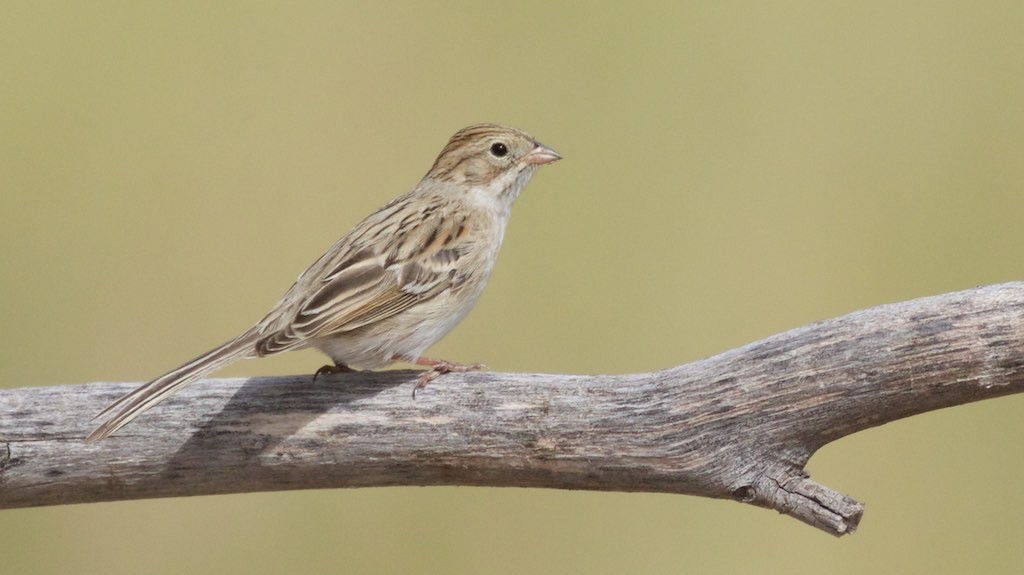Brewer's Sparrow
A species of Spizella Sparrows Scientific name : Spizella breweri Genus : Spizella Sparrows
Brewer's Sparrow, A species of Spizella Sparrows
Botanical name: Spizella breweri
Genus: Spizella Sparrows
Content
Description General Info
Description
Adults have grey-brown backs and speckled brown crowns, both with dark streaks, and a pale eye-ring. Their wings are brown with light wing bars and the underparts are pale grey. Their bill is pale with a dark tip and they have a long notched tail. They are similar in appearance to the clay-colored sparrow (S. pallida) but do not have a pale stripe on the crown or grey neck patch. Measurements: Length: 5.1-5.9 in (13-15 cm) Weight: 0.4-0.5 oz (11-14 g) Wingspan: 7.1-7.9 in (18-20 cm) The male sings to defend a nesting territory. The song is a long varied mix of notes and trills. Males have two distinct types of songs – classified as short and long songs. There are two distinct subspecies: Brewer's sparrow proper, Spizella breweri breweri Found in brushy areas, especially with sagebrush, in southern parts of western Canada and in the western United States. Timberline sparrow, Spizella breweri taverneri Found in thicketed areas around the tree line in the Rockies of British Columbia, Alberta, and northern Montana, the southern Yukon, and southeastern Alaska. These birds are somewhat darker and larger than the southern subspecies; some consider this to be a separate species. 
Size
14 cm (5.5 in)
Colors
Brown
Black
Gray
White
Life Expectancy
5.2 years
Nest Placement
Shrub
Clutch Size
1 - 5 eggs
Incubation Period
1 - 5 broods
Number of Broods
10 - 17 days
Nestling Period
5 - 8 days
Feeding Habits
Brewer's Sparrow predominantly consume grass seeds in winter, shifting to seeds and insects with seasonal changes. Limited by small bills, they eat small seeds like crabgrass and foxtail. Summer diets incorporate insects (half the intake) such as butterflies and beetles. Nestlings are fed spiders and a variety of insects.
Habitat
Brewer's Sparrow primarily inhabits sagebrush steppes, brushy plains, and the alpine areas near the treeline in the Rocky Mountains. This bird prefers environments at various altitudes, ranging from lowland sagebrush desert to high-elevation, open subalpine zones. The specific vegetation brewer's Sparrow seeks includes arid land shrubs, primarily sagebrush, and during winter, it may also frequent weedy fields and scrubby grasslands. Brewer's Sparrow avoids urban areas and is not typically found near dense human habitation.
Nest Behavior
The female brewer's Sparrow exclusively builds the nest, sometimes aided by the male providing materials. Construction occurs mainly in the mornings and spans 5–8 days for the first nest, while later nests take 2–3 days.
Nest Characteristics
Brewer's Sparrow typically selects a nesting site either on the ground within a grass clump or at a shrub's base, upgrading to elevated locations in foliage later in the season for protection. The nest is an open cup, crafted from interwoven grass stems and lined with a blend of coarse and fine grasses, rootlets, and hair. Its dimensions vary from 3.3 to 8.3 inches in diameter and 1.9 to 4.3 inches high, with a cup depth of 1 to 2.4 inches.
Dite type
Insectivorous
General Info
Feeding Habits
Bird food type
Bird Feeder Type

Small Hopper

Platform
Sounds
Song
Recording location: United States
Song
Recording location: United States
Behavior
Brewer's Sparrow display a range of intriguing behaviors throughout their daily activities. These birds forage on the ground, preferring open habitats like sagebrush, where they actively seek seeds and insects. Brewer's Sparrow exhibit a unique method of feeding on grass seeds by using their weight to bend tall grass stems to the ground, gaining access to the seeds. Their habitat interaction includes utilizing low perches as vantage points for spotting and pouncing on insect prey. Males of the species arrive earlier than females during the breeding season to establish territories, vigorously defending these areas from rivals. These birds often exhibit monogamous behavior, with pairing occurring soon after female arrival. Post-breeding, brewer's Sparrow form flocks that reside in various open and semi-open areas during winter.
Species Status
Not globally threatened.
Scientific Classification
Phylum
Chordates Class
Birds Order
Perching birds Family
New world sparrows Genus
Spizella Sparrows Species
Brewer's Sparrow 